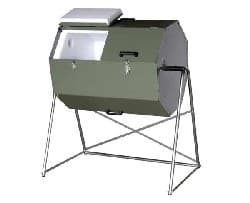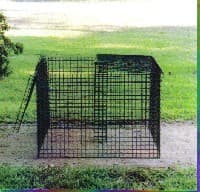Types of Garden Composters

Garden composters are the most popular way that home gardeners make compost. This garden tool is popular, because it holds the materials in a neat and tidy fashion. And, materials in composters decompose faster than the more passive method of creating an often unsightly, pest-ridden compost pile. Not all types of garden composters are created equal. That’s one of the reasons why there are many models on the market. You can choose from a wide variety of compost tumblers, bins, and barrels. Here are the basic types of garden composters. Choose the one that best fits “you” and your budget.
Compost Tumblers
Many manufacturers claim their tumbling composter will decompose raw materials in as little as 30 days or less. This is true…under ideal situations. Some of the factors include outdoor temperature, having the right mix of materials (greens and browns), how often you turn the composter, and chopping the material into small pieces. In reality, seldom are all conditions ideal. But, the point is, tumbling (or spinning) composters convert the material into usable compost faster than other methods. So, is, if you want to decompose raw materials quickly, a compost tumbler is for you.
How they work: Load raw materials into the compost tumbler. Use a good mixture of greens and browns. Every day or two, turn or “tumble” the barrel. Many models have handles to make tumbling easier. Tumbling mixes the materials together and provides aeration for faster decomposition.
The best compost tumblers are twin-barrel units. The material on one side can be decomposed and finished, while you are loading raw materials into the other side. They are usually the larger models. And, they carry the highest price. However, we feel this feature is well worth the extra cost.
Compost Barrels
A clean, empty 55-gallon drum is a good example of a compost barrel. The barrels can be larger or smaller. The barrel should have a screen or a lid, to keep pests out.
How they work: This is a passive method of composting. However, if you are strong enough, you can put it on its side and roll it to mix materials. This should be done frequently to speed up the decomposition process. The raw materials need air to decompose properly. Remove the lid regularly. Or, poke small holes in the top and/or sides. If you use a screen over the top, you will need to drain excess water from the bottom after rain. Also, it is a good idea to poke small holes in the bottom for drainage. If you don’t have access to 55 gallon barrels, manufacturers offer a wide variety of plastic compost barrels.

Plastic Compost Bins
The difference between plastic compost barrels and compost bins is the shape. Compost barrels are round. Plastic compost bins are rectangular. Often, manufacturers have a door at the bottom. Raw materials are loaded at the top of the bin. The compost at the bottom of the bin has been decomposing longer. You can open the door at the bottom, and remove the finished compost. Unlike barrels, it is impractical to roll the rectangular bins. So, this is largely a passive process.

Wire Compost Bins
A thick, heavy wire gauge compost bin is square or rectangular. Compost materials are open to the elements – air and water, aiding decomposition. It usually has a top and a bottom, keeping large pests out. Smaller pests and insects can get in and out.
How they work: Wire compost bins are a passive or partially passive process. They neatly contain the compost materials. However, smaller materials will fall out through the mesh. You can easily see how much the materials have decomposed. To speed up the process, open the top and mix the materials with a pitchfork.
Related Articles
People who like this article will also like:
The How-Tos of Composting – by Garden Hobbies.
Preparing Raw Materials – Shredding and ripping material into smaller pieces.
Please support our site. Shop for:
- rmmatthews100@hotmail.com
- 585-721-6528
- Rochester, NY
©1999-2024 GardenersNet.Com, All Rights Reserved

